Perhaps one day you entered your pool and noticed some swimming pool bugs (also known as water bugs) in the water, which you’re probably hoping to get rid of. In this article, I’ll be describing some of the most common swimming pool bugs you’re likely to find, as well as the best ways to remove them and prevent them from reappearing.
Regardless of the type of swimming pool bug that you find, you should properly sanitize the pool by cleaning out any algae and making sure the chemical levels of your pool water are where they should be.
Before we tackle the issue of removing the bugs, let’s first take a look at these bugs in general and what their lifestyles are like so that everything, later on, makes sense.
Article Contents
What Are Water Bugs?
Water bugs is an umbrella term that consists of any insects that live in or on the water. Water bugs include a variety of species, but most of them occur in the wild in ponds or other natural bodies of water. Of these bugs, the most common ones you’ll typically find in swimming pools are the water boatmen and the backswimmers.
Typically, the chemicals in your pool are enough to keep these critters at bay, but if they’re imbalanced for some reason, you may find yourself with an infestation quicker than you’d think.
Pool Beetles and Bugs that Swim
Here’s a generalized list of all the swimming pool bugs/water bugs that are known to swim in pools.
- Giant Water Bug
- Water Boatmen
- Backswimmers
- Dytiscidae (Predaceous Diving Beetles)
- Water Mites
- Crickets (some)
- Spiders (some)
- Beetles (some)
- Moths (some)
Other Beetles and Bugs that Like Swimming Pools
Unlike the beetles and bugs previously mentioned, the following beetles and bugs are not capable swimmers, but can still be found in swimming pools on occasion:
- Water Striders
- Christmas Beetles
- Thrips
- Jesus Bugs
- Mosquitoes
Now that we’ve categorized these bugs and beetles into swimmers and non-swimmers, let’s look a bit further into them in detail so that you’ll know what to pay attention to once you’re in the water.
What Are Giant Water Bugs?
The giant water bug has a flat, oval-shaped body that is either of a tan or brown color. Giant water bugs are typically found in freshwater ponds, marshes, and slow streams around the world.
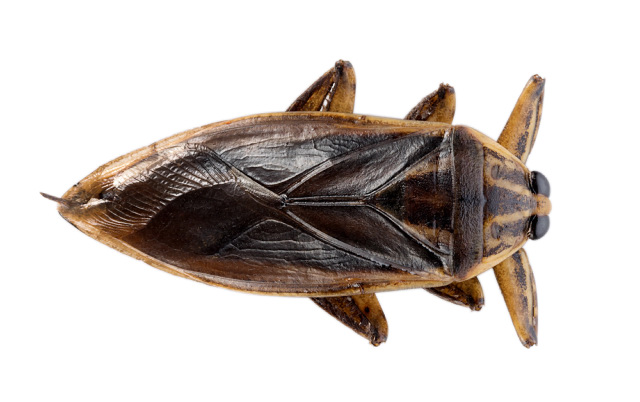
Do Giant Water Bugs Bite?
Giant water bugs can bite humans.
Giant water bugs, like the majority of other water bugs, are capable of flight. Therefore, it’s possible they either crawled or flew into the pool water. They are attracted to electric lights and other water bugs already present in the pool.
Giant water bugs prey primarily on tadpoles, small fish, insects, and other arthropods.
What Are Water Boatmen?
Water boatmen have a grayish, elongated, oval-shaped body that is 3 to 12 mm long. They have a conical beak and a broad head. Water boatmen are abundant around the world and can be found in a variety of aquatic habitats including brackish water, salt water, and freshwater streams and rivers.
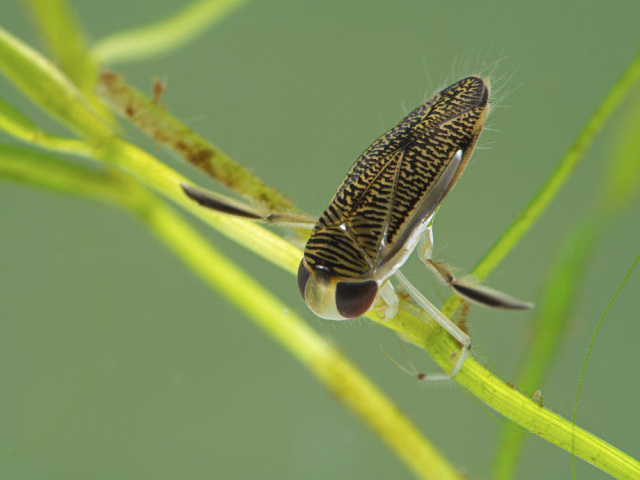
Do Water Boatmen Bite?
Water boatmen do not bite people.
Water boatmen mainly get into pools via flight. They are great fliers and swimmers and can also dive underwater by hanging onto an air bubble. They are attracted to algae and artificial light.
Water boatmen are mainly herbivores and consume algae, plants, and detritus.
Related Reading: How to Get Rid of Water Boatman Bugs from Pool
What Are Backswimmers?
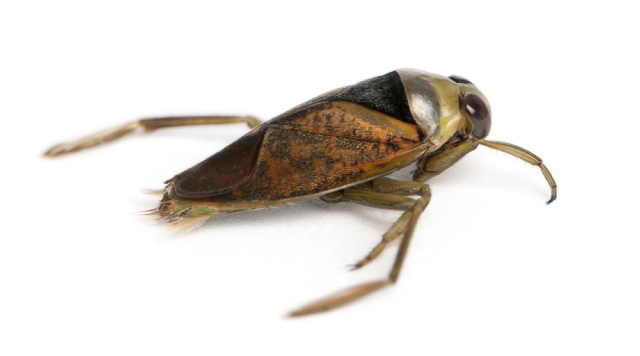
Backswimmers look similar to water boatmen in that both are slender and oval in shape. In addition, backswimmers are light brown in color and have large dark, red eyes.
They are commonly found in still waters across the world, with abundance, particularly in North America and the UK. Their habitats include ponds, lakes, and swimming pools.
Do Backswimmers Bite?
Backswimmers can bite humans if threatened, but their poisonous bites are merely painful and are not dangerous.
Backswimmers most likely flew to your pool from a freshwater source after becoming attracted to artificial light.
Backswimmers prey primarily on other aquatic insects (with water boatmen being a favorite in the pool) as well as small fish and tadpoles.
What Are Water Striders?
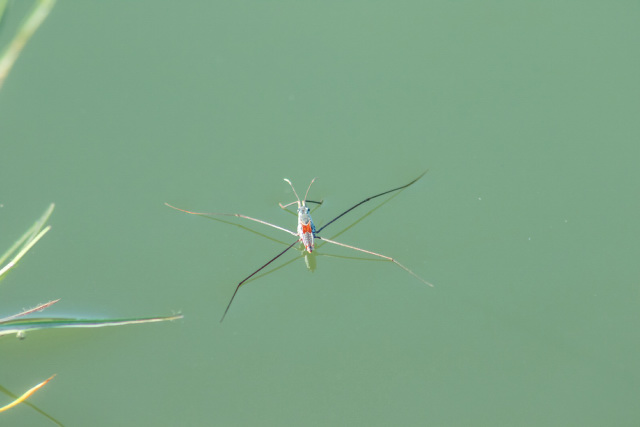
Water striders are aquatic bug-like creatures with four long dark legs, two antennae, and small white eyes. They are sometimes called Jesus Bugs. They can be found in any slow-moving freshwater habitat such as a pond, lake, pool, and mud puddles.
Do Water Striders Bite?
They do not bite people.
Water striders fly to your pool by following an artificial light.
Water striders eat algae, insects, and their larvae, such as mosquitoes and dragonflies, on the surface of the water.
What Are Christmas Beetles?
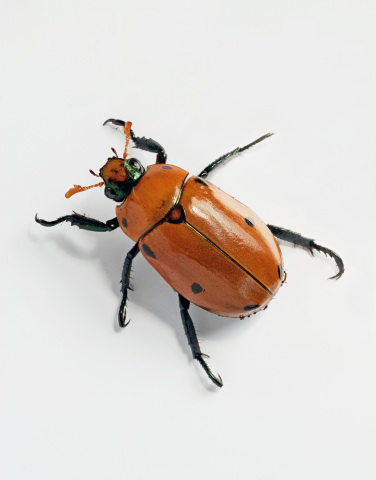
They are metallic orange-brown to gold in color, with various dark spots and some green tinges. They are endemic to Australia and prefer living in wooded areas.
Do Christmas Beetles Bite?
The females rarely bite but do if they believe it’s necessary; males do not bite.
The Christmas beetles can crawl into your pool after noticing fallen leaves in the water. They are also attracted to lights.
Their diet consists primarily of eucalyptus tree leaves, roots, and other decaying organic matter.
What Are Thrips?
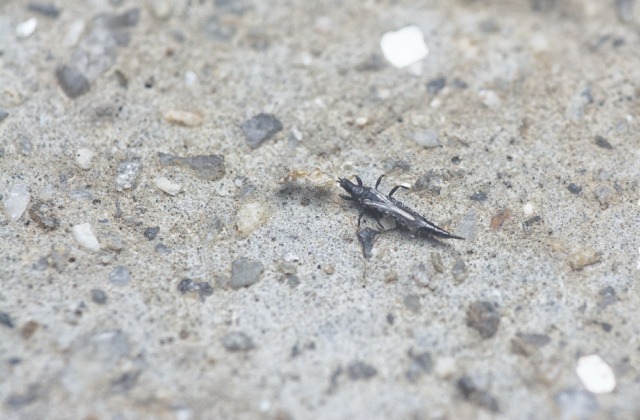
Thrips have slender, long bodies with fringed wings and asymmetric mouthparts. They are found throughout North America east of the Rocky Mountains in shaded, moist areas as well as gardens and urban outdoor spaces.
Do Thrips Bite?
They can bite people, but bites are harmless and only leave marks and potential rashes.
They might’ve gotten into your pool accidentally if they’ve been feeding on plants nearby. They might’ve been attracted to artificial light (like a pool light) or flew into the pool as well.
Their diet consists of flower petals, buds, and plant tissue.
What Are Dytiscidae?
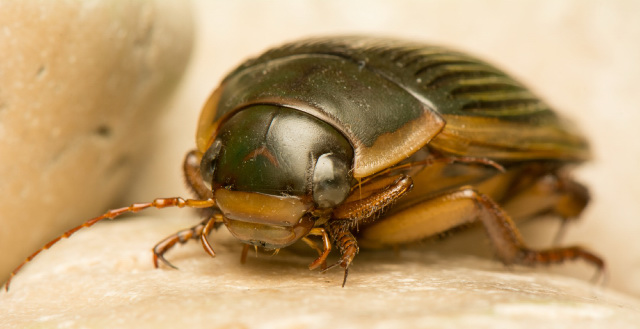
Dytiscidae is oval in appearance with a rounded sternum and dorsum. They lack a ventral spine and have flattened hind legs that can act as paddles. They are found on every continent except Antarctica, with shallow, still bodies of water being their preferred habitat.
Do Dystiscidae Bite?
They can bite, but their toxic bites only hurt a bit and don’t have any long-lasting effects.
They are attracted to bright lights at night and will crawl in the pool and feed on any insects found in the pool water.
Their typical prey includes tadpoles, glass worms, and other small water-dwelling creatures.
What Are Water Mites?
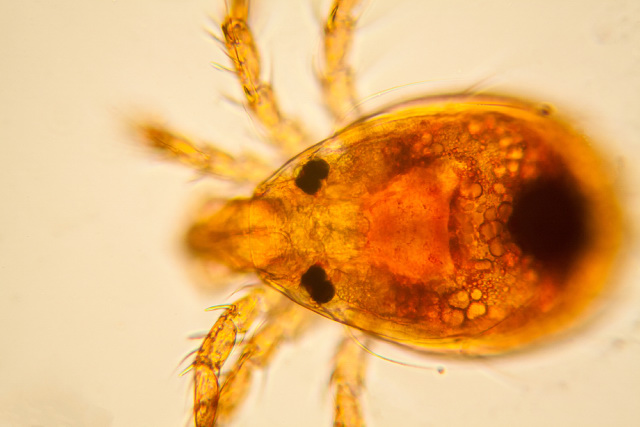
Water mites have a rounded body that has a small head, and four pairs of legs, and are either bright yellow or red in color. They are found worldwide and are in all freshwater habitats including streams, rivers, and ponds.
Do Water Mites Bite?
They can bite, but only if they remain on your skin for a long time. Their bites may cause skin irritation and itching, but there are no long-term side effects.
They can crawl into your pool if they notice algae and larvae floating on the water.
Their primary food source is algae and other bug larvae.
What Are Crickets?

Crickets contain a large number of species, but the ones you’ll probably find in your pool will have small bodies with large compound eyes and overlapping translucent wings. Crickets are found all over the world and in many habitats such as tree canopy and grasslands.
Do Crickets Bite?
Though they can bite people, it’s rare for their mouthparts to puncture the skin.
They might have been attracted to the plant leaves or insects (both dead and alive) that are already within the water.
Their diets are very diverse, but usually include a combination of insects, fruits, and plant material.
What Are Spiders?

All spiders have eight legs, a separated abdomen and cephalothorax, and either six or eight eyes. They are found all over the world in rural and urban homes, where they sometimes prefer dark and damp places.
Spiders can bite if threatened, with some being extremely venomous while others are non-venomous.
Spiders can climb into pools on their own to search for food or get blown into pools from heavy storms.
There are many spiders that can swim and also survive underwater for several hours. The Australian funnel-web spider is one such spider.
Spiders eat a variety of food ranging from flying insects to small reptiles.
What Are Beetles?

Beetles is an umbrella term that encompasses hundreds of thousands of species. However, they share common traits such as having six legs, a head, a thorax, and an abdomen. They can be found in forests, fields, shorelines, and agriculture.
Some beetles are known to bite humans if they feel threatened. They’re not deadly and usually cause temporary pain.
Typically, beetles enter the pool accidentally due to wanting a moist environment and falling in. In the case of Dytiscidae, they can also be attracted to the light or prey in the water.
Most beetles feed on plants, but some are known to consume animals such as roaches, dead mice, and crickets.
What Are Moths?

Moths are flying insects that have feelers with rough edges, feathery antennae, furry bodies, and sometimes hairy wings. They’re found around the world and in all habitats except polar regions.
Do Moths Bite?
The majority of moths feed on nectar and do not bite people, however, a few are known to bite on occasion though it ends in only a painful sting.
Moths most likely fly into pools due to a combination of the humidity (which they’re attracted to) and the presence of artificial light, like an underwater pool light.
They typically eat nectar, sap, and rotting fruit.
What Are Mosquitoes?

Mosquitoes are small flies that have two long wings, slender bodies, long legs, and elongated mouthparts. They prefer habitats with stagnant water so that they can lay eggs.
Female mosquitoes bite people quite often.
Mosquitoes commonly fly into attended pools where they can use the stagnant water to breed and lay eggs.
Mosquitoes consume a variety of food ranging from algae and bacteria to nectar and blood (females feed on the blood of many mammals and birds).
More details on the types of swimming pool bugs can be found here.
How to Get Rid of Swimming Bugs & Beetles
Here are the steps to removing and killing the swimming bugs and beetles from your pool. More details on the procedures can be found here.
1. Skim the Pool
Skim the pool with a net to remove floating bugs, insects, and beetles.
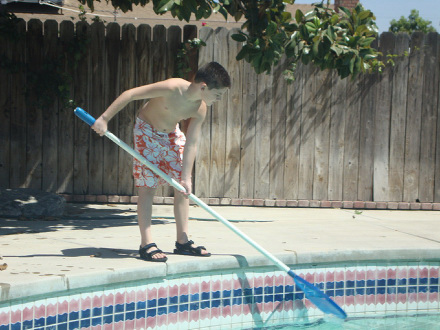
2. Remove Food
Remove the food that attracted the water bugs by scrubbing all surfaces to remove the algae and other microorganisms. Use a pool brush to rub the walls and floor of the pool.
It’s good practice to clean up the pool deck and surrounds too.
3. Vacuum the Pool
After brushing the pool walls, give the pool about 2 hours to allow debris to settle. Then manually vacuum the pool. This will deep clean everything and vacuum up any loosed particles
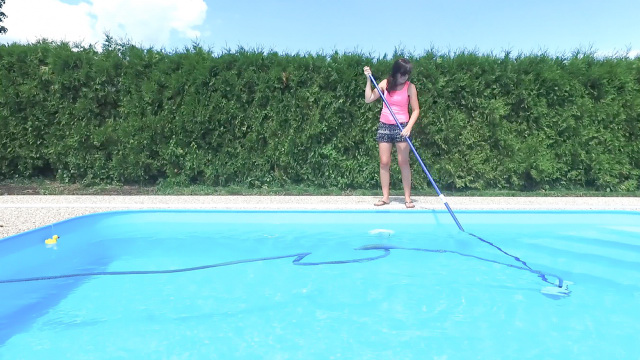
4. Shock the Pool
Shock the pool water by raising the chlorine levels to 20-50 ppm. This will kill any bacteria or algae or potential bug food that may be left.
Leave the pool overnight then run the filter.
5. Vacuum the Pool Again
Vacuum the pool a second time to ensure any particles that have settled are removed. If you have a lot of algae or debris on the bottom of the pool, use the “waste” setting on your filter.
Clean the filter when you’re done. For sand and DE filters, backwash them. For cartridge filters, remove them and hose them off.
6. Test Water and Balance
Now you want to test the water and check all the chemical levels are within range. Routinely test your pool water to keep the water clean and free of any potential food sources.
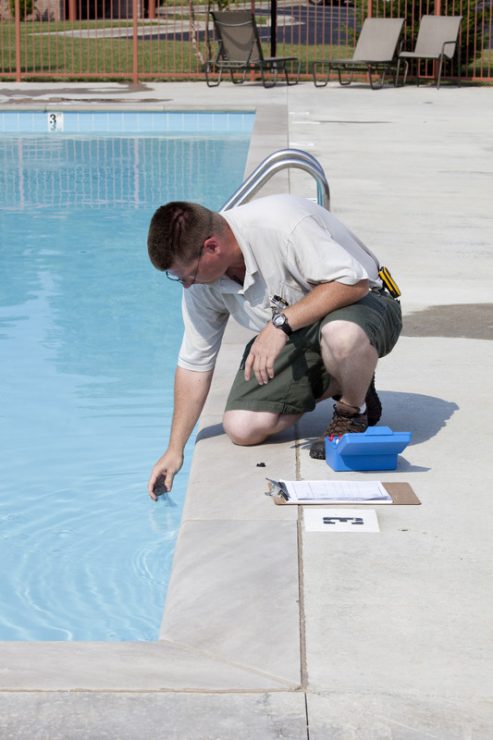
Related Reading: How To Shock A Swimming Pool For Beginners (In 6 Easy Steps)
Tips to Prevent Bugs & Beetles in Pool
Here are some tips you can take to prevent these bugs from reentering your pool:
- Pool skimmers should be emptied routinely so that they don’t get clogged up and have their functioning reduced.
- Chlorine should be tested for and maintained regularly so that algae are not given a chance to grow.
- Keep your pool covered whenever not in use so that bugs are not given the chance to enter.
- Turn off all outdoor and pool lights so that some of the water bugs won’t be attracted to the lights and by extension the pool.
- Regularly vacuum and brush your pool walls and floor to remove food sources
- Clean up the pool surrounds. Remove stagnant water which could attract mosquitoes and other bugs. Remove other potential food sources and prune trees that overhang the pool.
Related Reading: 7 Pro Pool Cleaning Tips
Final Thoughts
Swimming pool bugs are some of the last things you’ll want to find in your pool, but hopefully, this article can lessen your fears of the unknown and show you that removing these critters isn’t as difficult as you might’ve thought. As long as you keep the water regularly sanitized, you shouldn’t have to worry about this issue again.
Related Reading: 25 Ways to Keep Ducks, Geese & Birds Out of Pool

